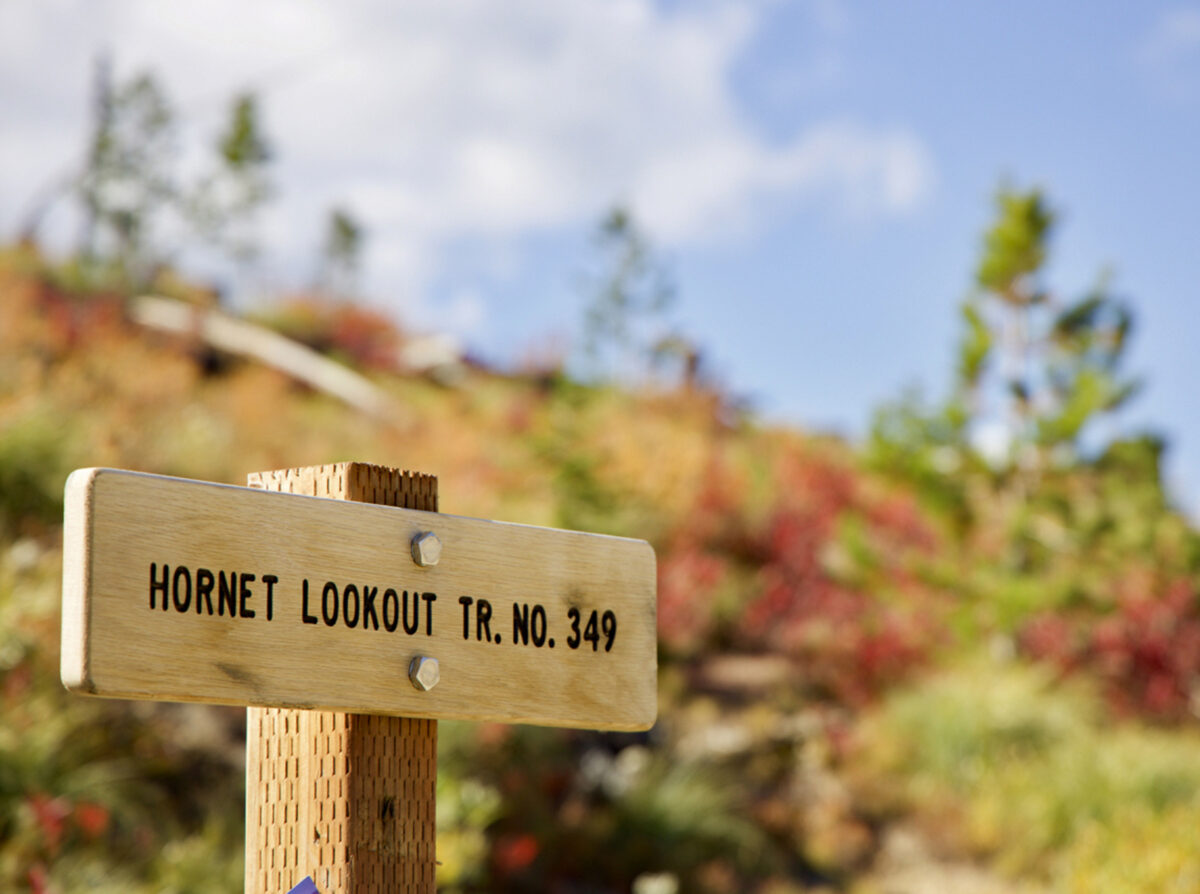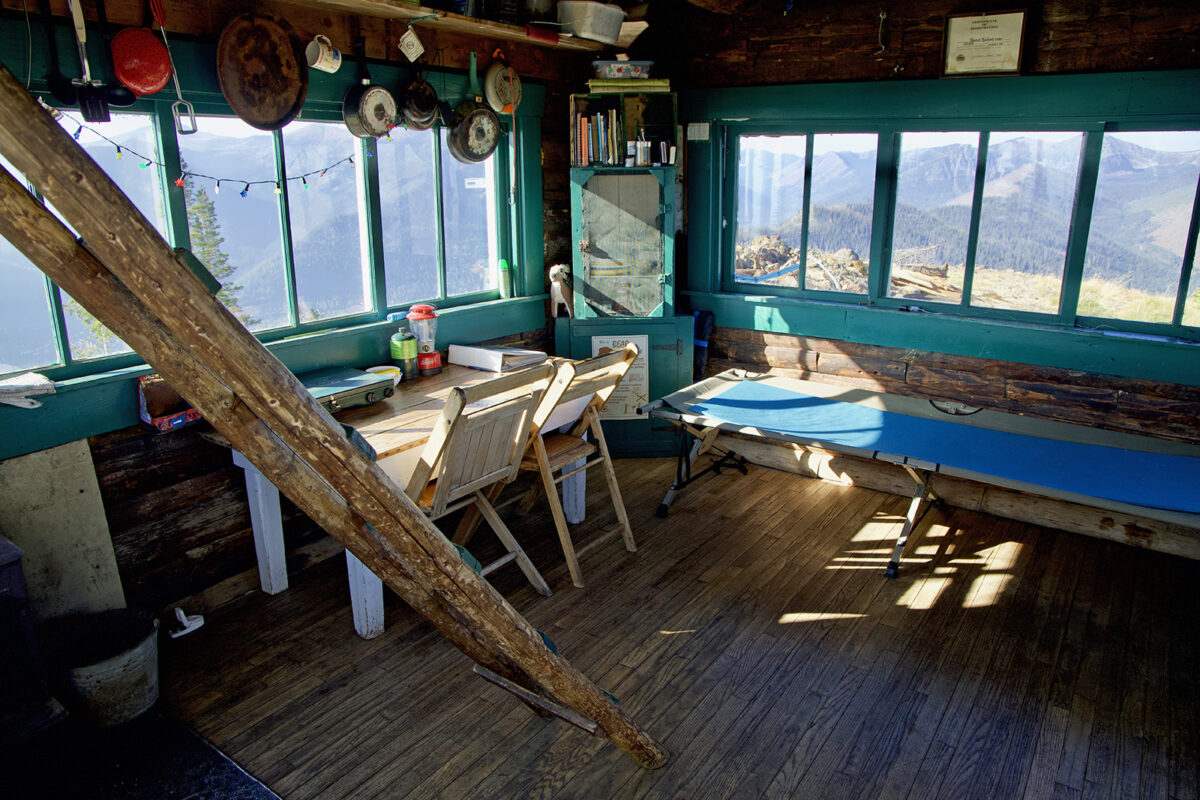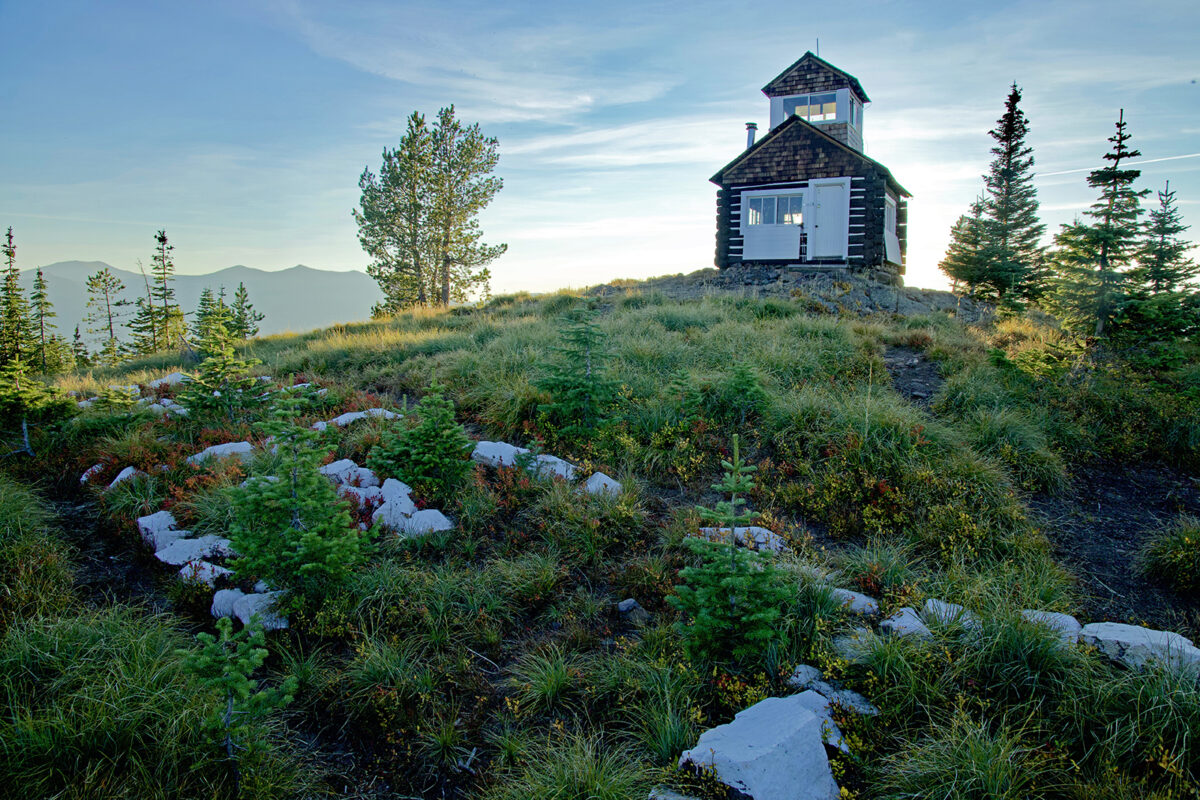
We had already been driving for nearly an hour up the North Fork Road when we turned onto Whale Creek Road where the sun played hide and seek, flickering through the deepening forest. As we neared the Canadian border and the trailhead to Hornet Lookout, I was more aware of getting farther away from home than I was of getting closer to our destination in this remote corner of northwest Montana.
The final leg to Hornet Lookout traveled up a narrow, coarse road that clung to the steep hillside of Hornet Mountain. It was a perfect autumn day, 70 and sunny. The blue skies and bright sunshine intensified the rich crimson red, fiery orange and canary yellow that formed a patchwork of color on the almost treeless landscape burned in the Wedge Fire of 2003.
We reached the end of the road on a flat saddle between the mountains, where a new sign marked the trailhead to Hornet Lookout. We hoisted packs laden with the food, water, clothing and sleeping gear needed for an overnight stay at the historic lookout and headed up the mountain. The hike was only a mile long, but fairly steep, climbing nearly 800 feet to reach the lookout at 6,744 feet.
The trail wove through silver snags where birds landed on the bony branches as if looking for a better view of the visitors ambling up the trail. I reached the timberline where I caught a glimpse of the lookout with its cupola popping up through spiky fir trees like a tall hat. In the silence and solitude of the moment, memories of an earlier visit rose.
It was June 15, 2000, and our family was celebrating our oldest daughter’s high school graduation with an overnight stay at Hornet Lookout, plucked away from the frenetic month of her last year in high school. We were the first visitors of the millennium and Mother Nature had a full slate of events waiting for us. The day began with blue skies streaked with white clouds. Remnants of snow remained in shady areas and on the north side of the mountain. Dewey pitched a snowball toward the girls and it exploded in the air, its fragments intercepted by Kelsey. A playful volley of snowballs preceded our entrée into the cabin, which was still shuttered. After entering the padlock combination we pushed the door ajar to reveal the dark, cool interior.

Daughters Risa and Kelsey helped their dad lift the heavy wood shutters that protected the windows of the ground-level lookout. Light flooded into the rustic log cabin. It had a storybook charm with its floral tablecloth, Coleman lantern, woodstove, a mishmash of kitchenware, and the handmade wooden tables.
We settled into our perch and quickly discovered the value of the lookout’s 360-degree views of Canada, Glacier Park, the Cabinet Mountains and the Whitefish Range as we watched billowy dark clouds spill over the surrounding mountains. We caught a flash of light and listened for the faint rumble that followed. It was both thrilling and frightening to watch the storm build and surround us. I pictured a lookout person alone and on edge, with the normal adrenalin of being on a mountaintop during a lightning storm combined with the responsibility of spotting fires ignited by lightning strikes. In spite of the rattling windows and rolling thunder claps, the cabin felt intimate and cozy as we waited for the storm to pass.
We cooked dinner on a campfire as the soggy landscape below filled with milky fog and the last of the day’s sunlight cast rainbows over Glacier Park and the iconic lookout. The show wasn’t over. A full moon rose in a pastel-colored sky over the snowy mountains in Glacier Park.
Darkness wrapped around us and we headed to the lookout cabin. There were only two cots, so our daughters curled up on ground pads on the floor next to us. It felt like a slumber party, but everyone was tired so the typical family banter didn’t last long before we all fell asleep. I remembered waking throughout the night and marking time by the movement of constellations across the crystal-studded sky.
Morning came early in mid-June, less than a week from summer solstice. The sky appeared to be set on fire as the sun rose in streaks of red and orange across a blue sky. I joined Dewey by the campfire where he heated water for coffee. The silence of the morning gave me lots of room for being grateful for this magical experience we were lucky to be sharing as a family.

Although it took place more than two decades after our inaugural trip to Hornet, our second visit on Oct. 4, 2022, seemed to match that calmer time in our lives — bright and colorful but with a newfound maturity, and the weather was steady with sun and clear skies, even as the thermometer did its rapid rise and fall, characteristic of the time of year and altitude.
It was a milestone year for the lookout, built 100 years ago, marked by a birthday celebration just a month before. The lookout had been repaired and the outhouse replaced, but its essence remained intact. The romance and intrigue of an earlier time felt imbedded in its log walls and wood plank floors.
We wandered along the steep hillside, taking in the fantastic views from different vantage points. Sunset dropped a shade over the landscape and turned the stage over to the sky. I was struck by the lack of lights and motor sound, a salve on a soul scraped by noisy construction, traffic and the dizzying population growth of the Flathead and Swan Valleys. We sat quietly by the fire transfixed by the little fire stars that danced from the flames. The fire flattened to a bed of glowing embers and my gaze turned to the night sky to spot my favorite constellations. Bedtime came early this visit, guided by the shorter days. I slept most of the night and was awake before sunrise, drawn outside when soft light began to creep over the mountains.

Deer skirted the treeline and the birds began to sing — more of a cheerful cacophony than a harmonious tune with various melodies colliding in the crisp morning air. After coffee and a breakfast of cinnamon rolls, we went in to explore the cabin before our departure. We climbed the log ladder to the cupola where the Osborne Fire Finder was mounted; a rotating circular device used to determine a compass point of the location of smoke or fire. I returned to the ground floor to snoop through the cupboards where there were food items left as a sort of offering to the next visitors or maybe just to lighten the pack out. In the corner was an eclectic collection of books where I discovered two warped journals speckled with mildew. I took the smelly books outside and sat down by the campfire where the morning sun began to cut through the cool air.
There were several decades of journal entries logged since the lookout was made available to the public through the Flathead National Forest’s cabin rental program. The resident mice were cast as main characters along with the friendly deer that often grazed near the cabin. A colorful story about the frightful appearance of three bears appeared borrowed from a children’s book. Visitors endured snowstorms and sleepless nights spent stuffing the woodstove and using socks and hats to plug the drafty window frames in what was described as a futile effort to stay warm. Many enjoyed the time free from phones and internet while one couple packed a computer to watch the classic horror movie, “The Thing.”
Visitors came from across the U.S. but I also discovered the names of many local friends and acquaintances. A group of college kids gathered to party, while others came in search of a quiet retreat, including newlyweds and couples celebrating birthdays and anniversaries. A solitary man from the east coast wrote of his search for purpose and answers, and reported that the people and places he discovered on his cross-country journey gave him hope. Many of the entries expressed appreciation for the preservation and opportunity to stay at the historic lookout.
I leafed through the pages and found our family’s journal entry in 2000, just signatures and the date. I looked around the cabin, picturing our family’s special time here 22 years ago. I was different now. Our family was different. Life was different. But Hornet Lookout was essentially the same. Maybe that’s the beauty of preserving historic places. The lookout hadn’t really changed. It was a different time — but the same place. And that in itself felt pretty magical.

A Look at Lookout History
The history of the fire lookout program began in the late 1800s when lookouts were enlisted to hike from a camp to a geographic prominence to scan the landscape for signs of fire or smoke. To gain a better vantage, they cobbled together early observatory platforms in trees and the modern lookout was born.
In the beginning, the lookouts extinguished fires themselves. In 1910, phone lines connected lookouts to a central clearing headquarters to ensure a fast emergency response.
The expanded lines of communication were critical to the lookout program’s evolution after the 1910 fires burned 3 million acres and claimed 87 lives in Washington, Idaho and Montana. By the 1930s, 5,000 lookouts had been built in the U.S.
The life of a lookout lonely. According to “The Trails of the Past,” 1930s lookouts were stationed on-site 24 hours a day between June 15 and Sept. 15 and a packer delivered supplies and mail just once or twice in a summer. In the evening, lookouts used the phone lines to catch up with one another. Along the North Fork, men sang and played music over the open line. A sense of humor came in handy during the long periods of solitude. According to the historic treatise “Trails of the Past: A Historical Overview of the Flathead National Forest,” lookouts “considered it amusing to post the fire slogan reading ‘Stay With It ‘Til It’s Out’ inside the outhouse door.”
The essential functions of fire lookouts began to diminish with the development of infrared detection and the use of airplanes and helicopters to patrol for fire starts. In 1966, only 21 lookouts were still occupied in the Flathead National Forest during fire season and by the early 1990s fewer than five staffed lookouts remained. Many fell into disrepair and were torn down or burned.
The National Forest Fire Lookouts Association was founded in 1990 to help protect and preserve forest fire lookouts. The Northwest Montana Lookout Association (NWMTLA) partners with local agencies to help complete condition assessments and to help preserve and stabilize lookouts in northwest Montana. According to NWMTLA, Montana had 639 lookouts in its heyday. Today, about 130 remain, and only 40 of them are seasonally staffed. Twelve of the remaining lookouts in northwest Montana, including Hornet Lookout, have joined the popular cabin-rental program.
Hornet Lookout began as an observation post with a cabin and a pole tower. In 1917, the original one-room building was used as accommodations for a lookout employee while actual fire patrol occurred outside.
The present building was constructed in 1922-23 by U.S. Forest Service seasonal staff at a cost of $719.38. Logs were obtained on-site and mules were used to pack other materials needed and to drag the logs into place. Hornet Lookout is a fairly unique standard D-1 lookout, a 14-by-14-foot cabin with a cupola and gabled roof designed by Dwight L. Beatty. The lookout was manned during fire season until 1946 and only sporadically after that. After sitting vacant, the lookout was restored and listed on the National Register of Historic Places in 1983.
Hornet Lookout’s 100-year birthday was celebrated on Sept. 10, 2022, at the Big Creek Outdoor Education Center hosted by the Flathead National Forest, Glacier Institute and Northwest Montana Lookout Association.
Hornet Lookout was added to the rental program in 1991. Cabins and lookouts are available for rent through the National Recreation Reservation System (NRRS) at the Recreation.gov website or by calling 1-877-444-6777.